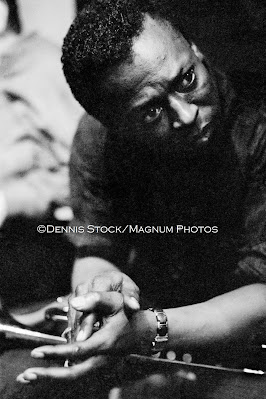On Tuesday, February 4th, 1958, at Columbia Records' studio on Manhattan's 30th St., a session was booked for the afternoon. It lasted from 2 to 6.30 pm, with Harry "Chappy" Chapman, an in-house veteran going back to the early 1940s, manning the control room.
The musicians and producer involved may have not known it at the time, but this was to be the first of two momentous occasions: this session and the following one, on March 4, were to be the last produced for Miles Davis by George Avakian, who had put him in the map by signing him to Columbia, the label he ended up staying with for thirty years, between 1955 and 1985.
These sessions on February and March 4 would also be the last ones by Davis's "first quintet", with Red Garland on piano and "Philly" Joe Jones on drums. Together, they'd form Milestones, a, er, milestone in Miles Davis's career, which may have seemed unsurpassable at the time. Not for long, though: his next small group album would be Kind of Blue.
 |
| Cover of Milestones. Photograph by Dennis Stock. |
The music publicly available from this session includes two takes each of "Two Bass Hit", "Straight, No Chaser", and "Milestones" (originally titled "Miles"), plus one take of the trio track "Billy Boy". A lot has been written about this, how "Two Bass Hit" and "Straight, No Chaser" go back to earlier days of bebop ebullience, respectively from Dizzy Gillespie and Thelonious Monk, how "Billy Boy" is a direct lift from Ahmad Jamal, younger than Davis and yet a strong model for him at the time, and how "Milestones"—with Miles on flugelhorn instead of trumpet—is an early incursion in modal playing.
Besides all that, and lending an attentive ear to the sparkling drumming by "Philly" Joe Jones (that snare drum, the rimshots on the fourth beat, the whole "Billy Boy"), I would only add that the slightly slower tempo of the alternate take of "Milestones" seems to give it a deeper pocket—on that take, note also how Davis syncopates his notes from 0:24.
However you listen—you have the whole session on Qobuz, here—use headphones or proper speakers so you don't miss the bass.
~
A perhaps less known aspect of that recording session is that famed Magnum photographer Dennis Stock shot it. Columbia had their own in-house photographer, the great Don Hunstein, but it seems that for this record—he also shot the cover—Columbia hired Stock. Given the unchanged clothes and that Davis plays flugelhorn on one of the pictures, it must have been February 4th.
The following are all the images I've been able to rescue from the internet. Enjoy!
 |
| "Philly" Joe Jones. |
 |
Paul Chambers, "Philly" Joe Jones,
Miles Davis, Red Garland. |
 |
Miles Davis, Red Garland. Garland, upset with Miles,
would not finish the March 4 session.
|
 |
| Paul Chambers, age 22. |
 |
Red Garland, Paul Chambers, Miles Davis,
"Cannonball" Adderley (jacket still on), John Coltrane.
|
 |
| Red Garland, Miles Davis, Paul Chambers, "Cannonball" Adderley. |
 |
| Red Garland, Miles Davis, Paul Chambers, "Cannonball" Adderley |
 |
Julian "Cannonball" Adderley.
|
 |
Miles Davis (on flugel, possibly playing "Milestones"),
"Cannonball" Adderley, John Coltrane.
 | Miles Davis (on flugel, possibly playing "Milestones"),
"Cannonball" Adderley, John Coltrane. |
|
 |
| John Coltrane. |
 |
| John Coltrane, "Philly" Joe Jones. |
 |
| John Coltrane, "Philly" Joe Jones. |
 |
| John Coltrane.
|
 |
| John Coltrane |
























No comments:
Post a Comment